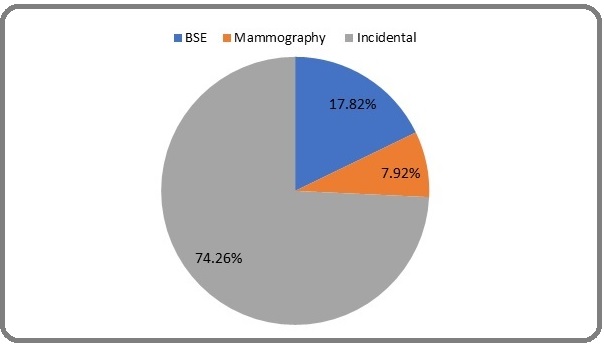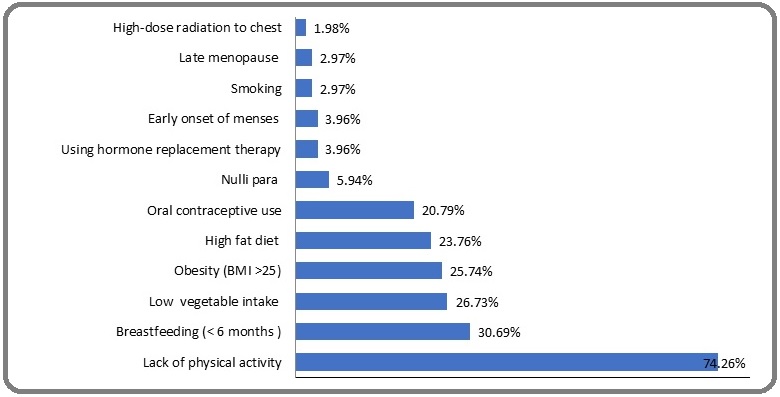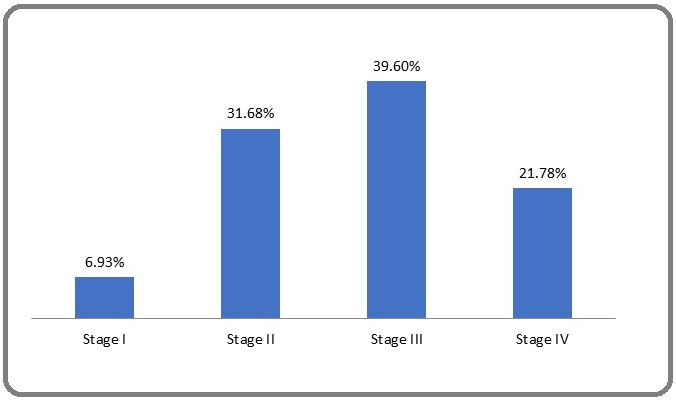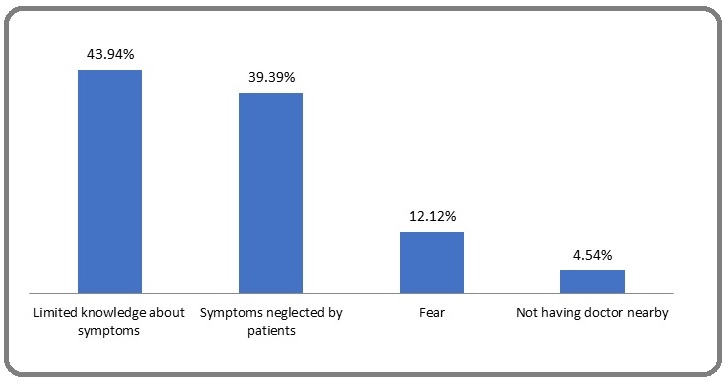Breast Cancer in Middle Euphrates Region of Iraq: Risk Factors, Presenting Symptoms and Time to Medical Help-Seeking
Download
Abstract
Background: Breast cancer is the most frequently occurring tumor and the first cause of death in females. Low level of understanding early symptoms leads to a late diagnosis and high mortality rates.
Aims: To describe presenting symptoms, risk factors, and medical care delays among breast cancer patients in Iraq.
Materials & Methods: A retrospective, descriptive study conducted in Al-Hussein center in Karbala province of Iraq between February 2012 and August 2020.
Results: There were 101 female patients with breast cancer, median age was 45 years. Most of our patients diagnosed incidentally and only 17.82% of our patients were performing breast self examination. Lack of physical activity was the most common risk factors in more than 74% of patients. Painless breast lump was the most frequent symptom in 85.14% of patients. Majority of our patients 58.42% asked medical help within six months. Limited knowledge about symptoms was the common barriers for early diagnosis in 43.94% of patients.
Conclusion: Lack of knowledge about breast cancer had a major concern in our region. Increasing awareness about early symptoms and risk factors is very important for early diagnosis and proper management.
Introduction
Worldwide, breast cancer accounting for almost 1 in 4 cancer cases among women. It is the most frequently diagnosed cancer in the vast majority of the countries [1]. In Iraq it represents more than 24% of total cancer cases making it a great challenge to the health system in our country [2].
There were several risk factors are known for breast cancer such as aging, female gender, smoking, alcohol, obesity, hormonal-replacement therapy and family history. Awareness of these factors and understanding of personal risks are essential factors for early identification, disease prevention and proper management [3-5]. Late diagnosis leads to high mortality rates among breast cancer patients, therefore researches on breast cancer prevention are performed largely around the world [6-7].
Breast self examination (BSE), screening mammography may help for early breast cancer detection [8-9]. Screening mammography for women ≥ 40 years is approved by all major US medical organizations. It is decrease mortality from breast cancer by about 20%-35% in women aged 50 to 69 years. In young age with high risk magnetic resonance imaging and ultrasound are being tested, but are not approved for screening the general population [10].
In this study, we investigated breast cancer risk factors, most common presenting symptoms and barriers of early diagnosis among Iraqi patients. It can help to provide basic information and to develop future treatment strategies in our country.
Materials and Methods
This a retrospective, descriptive study conducted in Al-Hussein cancer center in Karbala province of Iraq on breast cancer patients during period from February 2012 and August 2020. This center was established in November 2011 with oncology & hematology wards. It covers not only Karbala population but other patients from Middle Euphrates region of Iraq are referred to this center for solid & hematological malignancy treatment [11-12]. We selected 101 female breast cancer patients, they were asked directly and all the information were recorded through their regular visits to our center.
The questionnaire included: Section A, section B and section C. Section A dealt with socio-demographic details including: Age, marital status, number of pregnancies, family history, level of education and family income. Regarding income, we divided our patients into: low monthly income less than 500,000 Iraqi Dinars (IQD), middle monthly income within 500,000 – 1,000,000 IQD and high income over 1,000,000 IQD per month [13].
In Section B, the questions were on presenting symptoms, stage, barriers and duration for seeking medical help. In section C, the questions raised about risk factors for breast cancer in our patients.
Patients with non-conclusive results were excluded from this study. Collected information was kept confidential. This study was approved by review ethical committee of Karbala teaching hospital, Iraq.
Results
Socio-demographic data
There were 101 women enrolled in our study. Median age was 45 years, range was (25-70) years. Majority of our patients were married in 91 patients (90.09%) and 35 patients (34.65%) were illiterates. Only 13 patients (12.87%) had family history of breast cancer. Other data are explained in (Table 1).
| Variable | Number (Percent) |
| Age in years | |
| 20-30 | 7 (6.93) |
| 31-40 | 24 (23.76) |
| 41-50 | 41 (40.60) |
| 51-60 | 21 (20.79) |
| > 60 | 8 (7.92) |
| Marital status | |
| Single | 4 (3.96) |
| Married | 91 (90.10) |
| Divorced | 1 (0.99) |
| Widowed | 5 (4.95) |
| Education | |
| Illiterate | 35 (34.65) |
| Primary school | 12 (11.89) |
| Secondary school | 16 (15.84) |
| Higher education | 38 (37.62) |
| Occupation | |
| Employed | 26 (25.75) |
| Unemployed | 75 (74.25) |
| Family income | |
| Low | 32 (31.68) |
| Middle | 56 (55.44) |
| High | 13 (12.88) |
| Number of pregnancies | |
| 0 | 6 (5.94) |
| 1 | 6 (5.94) |
| 2-4 | 48 (47.52) |
| >4 | 41 (40.60) |
| Family history of breast cancer | |
| Yes | 13 (12.87) |
| No | 88 (87.13) |
Most of our patients 74.26% diagnosed incidentally after developing symptoms, while 17.82% performed BSE and only 7.92% had opportunity to screening mammography (Figure 1).
Figure 1. The Distribution of Different Procedures of Early Detection among Studied Subjects.

Risk factors
The most common risk factors for breast cancer in our patients were: Lack of physical activity in 75 patients (74.26%) followed by breastfeeding (< 6 months) in 31 patients (30.69%), low vegetable intake (< 3 times per week) in 27 patients (26.73%), obesity in 26 patients (25.74%), high fat diet (> 3 times per week) in 24 patients (23.76%), oral contraceptive use in 21 patients (20.79%), nulli para in 6 patients (5.94%), using hormone replacement therapy in 4 patients (3.96%), early onset of menses (before the age of 12 years) in 4 patients (3.96%), smoking in 3 patients (2.97%), late menopause (after the age of 55 years) in 3 patients (2.97%) and high-dose radiation to chest in 2 patients (1.98%) as shown in (Figure 2).
Figure 2. Distribution of Different Known Risk Factors among Our Breast Cancer Patients.

Breast cancer symptoms
Most frequent symptom was painless breast lump in 86 patients (85.14%) followed by lump under armpit in 36 patients (35.65%), breast asymmetry in 24 patients (23.77%), nipple retraction in 19 patients (18.82%), change in breast shape in 18 patients (17.82%), dimpling of breast skin in 15 patients (14.86%), breast pain in 10 patients (9.90%), nipple discharge in 7 patients (6.94%) and bloody discharge in 4 patients (3.97%) as shown in (Table 2).
| Variable | Nuimber (Percent) |
| Painless breast lump | 86 (85.14) |
| Lump under armpit | 36 (35.65) |
| Breast asymmetry | 24 (23.77) |
| Nipple retraction | 19 (18.82) |
| Change in breast shape | 18 (17.82) |
| Dimpling of breast skin | 15 (14.86) |
| Breast pain | 10 (9.90) |
| Nipple discharge | 7 (6.94) |
| Bloody discharge | 4 (3.97) |
Presenting stages
The most common presenting stage in our patients was stage III in 40 patients (39.60%) followed by stage II in 32 patients (31.68%), stage IV in 22 patients (21.78%) and stage I in 7 patients (6.93%) as shown in (Figure 3).
Figure 3. Distribution of Presenting Stages among Studied Population.

Time to reach final diagnosis
Most of our patients asked medical help within 1 - 6 months in 59 patients (58.42%) while 35 patients (34.65%) diagnosed within 1 month, 6 patients (5.94%) diagnosed within 7-12 months and 1 patient (0.99%) diagnosed after one year (Table 3).
| Time | Number (Percent) |
| < 1 month | 35 (34.65) |
| 1 month - 6 months | 59 (58.42) |
| 7 months – 12 months | 6 (5.94) |
| > 12 months | 1 (0.99) |
| Total | 101 (100) |
Barriers for early diagnosis
The most common barrier for urgent medical help was limited knowledge about symptoms in 43.94% followed by neglect in 39.39%, fear in 12.12% and not having doctor nearby in 4.54% as shown in (Figure 4).
Figure 4. Frequency of Different Barriers for Early Diagnosis.

Discussion
Cancer patients tend to present with heterogonous presentations and complications making treatment of those patients as a serious issue. Detection of the disease in its early stages before the appearance of signs & symptoms improve outcomes dramatically [14-20]. This study was carried out to understand risk factors, presenting symptoms and barriers to urgent medical help among breast cancer patients in Middle Euphrates region of Iraq. Median age in our study was 45 years, this younger than median age in other parts of Iraq (49 years), Turkey (51 years) and US (62 years) this may be explained by our small sample size and short follow- up period [21-23]. Majority of our patients diagnosed incidentally, 17.82% performed BSE and only 7.92% performed screening mammography. Same results from Africa where majority of patients diagnosed incidentally after symptoms development. Unfortunately, our screening results revealed low compliance comparing to previous studies in other parts of Iraq, US, Saudi Arabia, Turkey and Iran [24-30].
Unhealthy life style was the main risk factor in our patients same results among Indian and Jordanian women [31-32]. But in Europe the use of hormone therapy, older age at the first birth and smoking were common risk factors [33]. On other hand about 12.8% of our patients had family history of breast cancer. This lower than previous studies in Iraq (18.7%) Turkey (15.8%) but it is higher than in India (4.2%) [22,34-35].
Breast painless lump was the most reported symptom among our patients, same results in previous studies in Iraq, India, Turkey and UK [22, 34, 36]. Our patients tend to present in late stages, this was agreed with results in previous studies in Iraq and Africa where most of patients presented in advance stages. However, European women are more likely to present when the disease is still in its early stages [37-38].
Most of our patients asked medical help within six months after observing symptoms. This is longer than time in neighboring and high-income countries where the median time for medical consultation was 7-16 days only [39-40]. The most frequent barrier for early diagnosis in our study was limited knowledge about symptoms and neglect which is same in neighboring and African countries [26, 40].
In conclusion, most of our patients diagnosed incidentally after appearance of symptoms. Unhealthy life style was the most common risk factor and breast lump was the most frequent symptom. Our patient tends to present in advance stages and majority of them wait 1-6 months before final diagnosis. Limited knowledge about symptoms and neglect were the main barriers for early diagnosis. Our findings show the need for community awareness and education programs about breast cancer signs, symptoms and treatment options among Iraqi women.
References
- Global cancer statistics 2018: GLOBOCAN estimates of incidence and mortality worldwide for 36 cancers in 185 countries Bray Freddie, Ferlay Jacques, Soerjomataram Isabelle, Siegel Rebecca L., Torre Lindsey A., Jemal Ahmedin. CA: A Cancer Journal for Clinicians.2018;68(6). CrossRef
- Some Facts About Cancers in Karbala province of Iraq, 2012-2020 Mjali Ahmed, Najeh Hasan Al Baroodi Bushra. Asian Pacific Journal of Cancer Care.2020;5(2). CrossRef
- Evaluation of the level of knowledge of Egyptian women of breast cancer and its risk factors.A cross sectional study Allam MF, Abd Elaziz KM. Journal of Preventive Medicine and Hygiene.2012;Vol 53. CrossRef
- Cancer Awareness among University Students in Turkey Kurtuncu Meltem, Akhan Latife Utas, Celik Sevecen, Alkan Isin. Asian Pacific Journal of Cancer Prevention.2014;15(10). CrossRef
- Association between Female Breast Cancer and Different ABO Blood Groups & Rh Factor in the Sulaymaniyah Province of Iraqi Kurdistan Mjali Ahmed, Sheikha Anwar, Amin Hazha Abdullah, Al-Anssari Mohammed Jawad, Aljawdah Zahraa Dheyaa Azeez, Abbas Saja Khudhair. Indian Journal of Public Health Research & Development.2019;10(6). CrossRef
- Breast Cancer Awareness among Turkish Nursing Students Celik Sevim, Tasdemir Nurten, Sancak Hulya, Demirel Merve, Akman Ozlem, Kara Merve. Asian Pacific Journal of Cancer Prevention.2014;15(20). CrossRef
- A review of breast cancer awareness among women in India: Cancer literate or awareness deficit? Gupta A., Shridhar K., Dhillon P.K.. European Journal of Cancer.2015;51(14). CrossRef
- Awareness and attitudes regarding breast cancer and breast self-examination among female Jordanian students Suleiman AmalK. Journal of Basic and Clinical Pharmacy.2014;5(3). CrossRef
- The experience of breast cancer screening Levshin V, Fedichkina T, Droggachih V. Eur J Cancer.1998;34(1005):S95.
- Screening for Breast Cancer Elmore Joann G.. JAMA.2005;293(10). CrossRef
- Gynecological Cancer in Middle Euphrates Region of Iraq , 2012-2020 Mjali Ahmed, Jawad Safaa Ayad, Al Baroodi Bushra Najeh Hasan. Asian Pacific Journal of Environment and Cancer.2020;3(1). CrossRef
- Imatinib Mesylate Adherence in Chronic Myeloid Leukemia Patients: Data from Middle Euphrates Region of Iraq Mjali A, Abbas SK. Sys Rev Pharm.2021;12(1):83-87.
- United Nation Publication Fund-Iraq . Demographic Survey , Kurdistan Region of Iraq. 2018 [cited 2020 July 2] Available from: https://iraq.iom.int/files/KRSO_IOM_UNFPA_Demographic_Survey_Kurdistan_Region_of_Iraq.pdf..
- Chronic myeloid leukemia patient with isolated central nervous system blast crisis Mjali A, Kareem YA, Al–Shammari HH, et al . World J Pharm Pharm Sci.2019;8(9):111-117. CrossRef
- Myeloid sarcoma as the presenting symptom of chronic myeloid leukemia chronic phase: A case report Mjali A, Hasan DM, Al-Anssari MJ, et al . World J Pharm Res.2017;6(13):10-15.
- Primary Cutaneous Aspergillosis in Acute Myeloid Leukemia Patient: A Case Report Mjali A, Kehiosh HJ, Al-Ansari MJ, et al . World J Pharm Res.2017;6(15):105-111.
- Skin Reaction at Site of Intrathecal Methotrexate Mjali A, Al Baroodi BN, Al–Shammari HH, et al . World J Pharm Res.2019;8(10):170-173. CrossRef
- Acute Promyelocytic Leukemia in Third Trimester Pregnant Women Treated with All-Trans-Retinoic Acid Mjali A, Abbas SK, Mutlag JH, et al . World J Pharm Pharm Sci.2019;8(9):146-151.
- Vincristine Induced Vocal Cord Paralysis in Patient with Diffuse Large B-cell Lymphoma: A Case Report Mjali A, Al-Anssari MJ, Al-Shammari HH. World J Pharm Res.2017;6(12):11-15.
- Proliferating Trichilemmal Tumor: Case Report Mjali A, Alshami MA, Metib NJ, et al . Karbala J Med.2017;10(2):2800-2803.
- Breast Cancer in Iraq, Incidence Trends from 2000-2009 AL-Hashimi Muzahem Mohammed Yahya, Wang Xiang Jun. Asian Pacific Journal of Cancer Prevention.2014;15(1). CrossRef
- Breast Cancer in Turkey; An Analysis of 20.000 Patients with Breast Cancer Ozmen Vahit, Ozmen Tolga, Dogru Volkan. European Journal of Breast Healt.2019;15(3). CrossRef
- Cancer statistics, 2016 Siegel Rebecca L., Miller Kimberly D., Jemal Ahmedin. CA: A Cancer Journal for Clinicians.2016;66(1). CrossRef
- Self-Detection Remains a Key Method of Breast Cancer Detection for U.S. Women Roth Mara Y., Elmore Joann G., Yi-Frazier Joyce P., Reisch Lisa M., Oster Natalia V., Miglioretti Diana L.. Journal of Women's Health.2011;20(8). CrossRef
- Breast cancer in the world and Turkey Ozmen V. J Breast Health.2008;4(2):6-12.
- Perceived barriers to early diagnosis of breast Cancer in south and southwestern Ethiopia: a qualitative study Getachew Sefonias, Tesfaw Aragaw, Kaba Mirgissa, Wienke Andreas, Taylor Lesley, Kantelhardt Eva J., Addissie Adamu. BMC Women's Health.2020;20(1). CrossRef
- Screening mammography and breast self-examination: Attitudes and practices of women in the Eastern Province of Saudi Arabia Bakr Radwa, AL-Mulhim Fatima, Almedallah Dana, Alkaltham Nourah, Alotaibi Abdullah, Alnoaim Saud. Saudi Journal for Health Sciences.2018;7(2). CrossRef
- Awareness of breast cancer risk factors and practice of breast self examination among high school students in Turkey Karayurt Özgül, Özmen Dilek, Çetinkaya Aynur Çakmakçi. BMC Public Health.2008;8(1). CrossRef
- Breast cancer. Knowledge, attitudes and practices of breast self examination among women in Qassim region of Saudi Arabia Jahan S, Al-Saigul AM, Abdelgadir MH. Saudi Med J.2006;27(11):1737-1741.
- Breast cancer in Iran: need for greater women awareness of warning signs and effective screening methods Montazeri Ali, Vahdaninia Mariam, Harirchi Iraj, Harirchi Amir, Sajadian Akram, Khaleghi Fatemeh, Ebrahimi Mandana, Haghighat Shahpar, Jarvandi Soghra. Asia Pacific Family Medicine.2008;7(1). CrossRef
- Risk factors for breast cancer among Indian women: A case–control study Antony MP, Surakutty B, Vasu TA, et al . Niger J Clin Pract.2018;21(4). CrossRef
- Risk factors for breast Cancer among Jordanian women: a case-control study Al Qadire M, Alkhalaileh M. Iran J Public Health.2018;47(1):49.
- Breast Cancer in Europe: Epidemiology, Risk Factors, Policies and Strategies. A Literature Review Aljohar Bashaier Abdullah, Kilani Mohammed Ahmedhani. Global Journal of Health Science.2018;10(11). CrossRef
- Demographic and clinical profiles of female patients diagnosed with breast cancer in Iraq Alwan NA, Tawfeeq FN, Mallah NA. J Contemp Med Sci.2019;5(1):14-19.
- Analysis of Demographic Characteristics and Treatment Outcome of Breast Cancer Patients in a Tertiary Cancer Centre Velappan Arumugam, Shumugam Deepa. IOSR Journal of Dental and Medical Sciences.2017;16(05). CrossRef
- Typical and atypical presenting symptoms of breast cancer and their associations with diagnostic intervals: Evidence from a national audit of cancer diagnosis Koo Minjoung Monica, von Wagner Christian, Abel Gary A., McPhail Sean, Rubin Greg P., Lyratzopoulos Georgios. Cancer Epidemiology.2017;48. CrossRef
- Pattern of Presentation of Patients With Breast Cancer in Iraq in 2018: A Cross-Sectional Study Mutar Mohammed Tareq, Goyani Mohammed Saleh, Had Ali Mohammed, Mahmood Aqeel Shakir. Journal of Global Oncology.2019;(5). CrossRef
- Epidemiology of Breast Cancer in Europe and Africa Abdulrahman Ganiy Opeyemi, Rahman Ganiyu Adebisi. Journal of Cancer Epidemiology.2012;2012. CrossRef
- Breast Cancer Care in Jordan Abdel-Razeq Hikmat, Mansour Asem, Jaddan Dima. JCO Global Oncology.2020;(6). CrossRef
- Delay in Presentation, Diagnosis, and Treatment for Breast Cancer Patients in Jordan Ahmad Abu-Helalah Munir, Alshraideh Ahmad Hussam, Al-Hanaqtah Mo'tasem, Da'na Moh'd, Al-Omari Asim, Mubaidin Rasmi. The Breast Journal.2015;22(2). CrossRef
License

This work is licensed under a Creative Commons Attribution-NonCommercial 4.0 International License.
Copyright
© Asian Pacific Journal of Cancer Care , 2021
Author Details
How to Cite
- Abstract viewed - 0 times
- PDF (FULL TEXT) downloaded - 0 times
- XML downloaded - 0 times